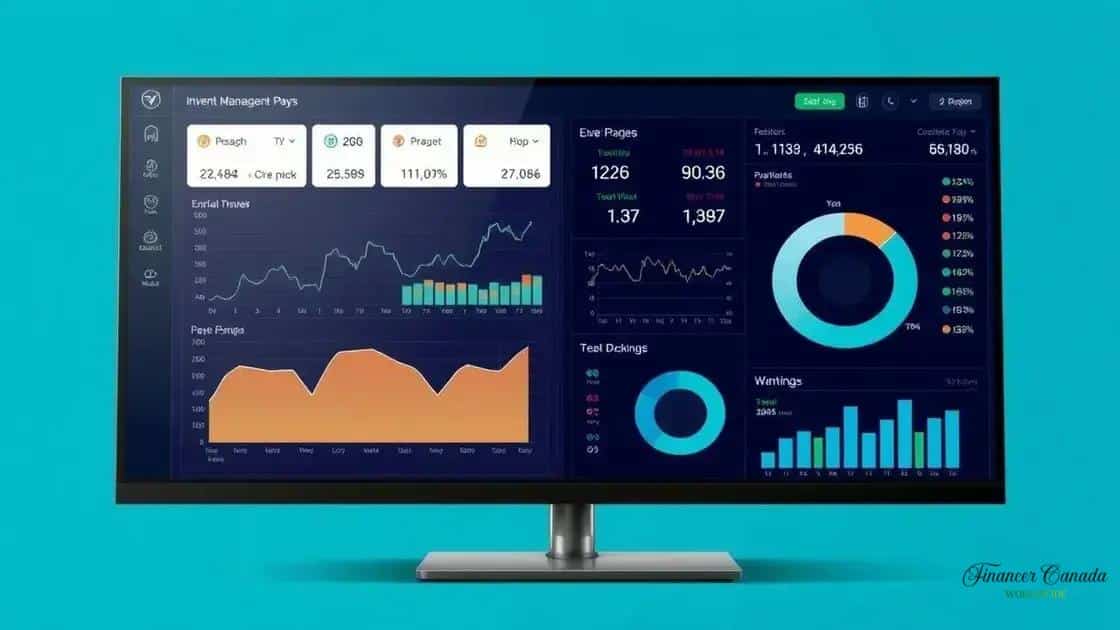The rise of robo-advisors in personal finance

The rise of robo-advisors in personal finance offers automated investment management at lower costs, enhanced accessibility, and greater ease of use while adapting to evolving market trends and investor preferences.
The rise of robo-advisors in personal finance has changed the landscape of investing recently. Have you ever wondered how these automated services can simplify your financial journey?
Understanding robo-advisors
Understanding robo-advisors is key to grasping the modern financial landscape. These automated platforms offer investment management services that traditionally required human advisors. They are appealing because they combine technology with user-friendly interfaces.
What are robo-advisors?
Robo-advisors use algorithms to manage investments based on user profiles and risk tolerance. They take into account your financial goals, timeframe, and how much risk you’re willing to take. This is done without the need for a dedicated financial advisor.
How do they work?
The process starts when you create an account and answer a series of questions about your finances. Based on your answers, the robo-advisor will design a personalized investment portfolio. This portfolio is usually diversified across various asset classes to minimize risk.
- Low fees compared to traditional advisors
- Easy account setup and management
- Automated rebalancing of your portfolio
- Access to financial advice through a digital platform
Another advantage of using robo-advisors is their ability to automatically rebalance your investments. This means that as market conditions change, your asset allocation will adjust to maintain your desired risk level. It’s a simple, effective way to keep your portfolio aligned with your goals.
Who can benefit from robo-advisors?
Robo-advisors are suitable for anyone looking to invest without the complexities of traditional financial advising. They are particularly beneficial for beginners who may not have significant investment experience. The accessibility means that even those with minimal funds can start investing.
Ultimately, understanding how robo-advisors work helps you make informed decisions about your investments. They offer a blend of convenience and efficiency, making them a popular choice among investors today.
How robo-advisors work

Understanding how robo-advisors work can demystify the investment process. These tools leverage technology to manage your investments with minimal human intervention, making finance more accessible.
The investment process
When you sign up for a robo-advisor, your journey begins with a questionnaire. This series of questions is designed to assess your financial situation, investment goals, and risk tolerance. Based on your responses, the platform will create a tailored investment plan that aims to align with your objectives.
- Initial assessment of your financial goals
- Personalized portfolio creation
- Monitoring of your investments over time
- Automatic adjustments and rebalancing
Once your portfolio is created, it will be comprised of various assets, such as stocks, bonds, and even ETFs. This diversification helps spread risk. Robo-advisors employ algorithms to ensure your portfolio stays balanced, often using a strategy known as rebalancing.
Ongoing Management
After your investments are set, the robo-advisor continuously monitors your portfolio. If certain assets perform better or worse than expected, the platform adjusts your allocations accordingly. This helps maintain your desired level of risk without requiring you to constantly manage your investments.
Fees associated with robo-advisors tend to be lower than traditional financial advisors since they rely heavily on automation. You benefit from efficient services at a fraction of the cost, making investing more affordable.
Overall, the transparent, data-driven process of how robo-advisors operate makes them appealing to both new and seasoned investors. Plus, their user-friendly interfaces make managing investments straightforward and accessible.
Benefits of using robo-advisors
The benefits of using robo-advisors are numerous and can greatly enhance your investing experience. These digital platforms have made it easier for individuals to manage their finances without the complexities usually associated with traditional investing.
Cost-effectiveness
One of the main advantages is the lower fees associated with robo-advisors. Traditional financial advisors often charge high fees that can eat into your investment returns. In contrast, robo-advisors typically have much lower fees, making investing more accessible to everyone.
- Reduced management fees
- No hidden costs
- Affordability for beginners
Another key benefit is the simplicity of the investment process. With robo-advisors, the steps are straightforward. You complete a questionnaire, and the platform does the rest. This service takes the complexity out of knowing which assets to buy, as the robo-advisor creates a diversified portfolio tailored to your needs.
Automatic rebalancing
Robo-advisors also offer automatic rebalancing of your investment portfolio. This means that your portfolio is continuously monitored, and adjustments are made whenever necessary. If certain investments perform better or worse than expected, the platform automatically adjusts your holdings to maintain your desired risk level.
This feature allows you to stay on track with your financial goals without the hassle of manual management. It’s a great way to ensure your investments are aligned with your risk tolerance, especially as market conditions change.
Moreover, robo-advisors provide accessibility that is hard to match. Most of these platforms can be accessed through user-friendly websites or mobile apps. You can check your portfolio whenever you like, giving you access to your investments at your fingertips.
In summary, the benefits of using robo-advisors include lower costs, simplified processes, automatic management, and unmatched accessibility. These factors make them a popular choice for many investors looking to streamline their financial journeys.
Comparing robo-advisors with traditional advisors

Comparing robo-advisors with traditional advisors reveals important differences in how investment services are delivered. These differences can influence your choice depending on your financial needs and preferences.
Cost
One significant point of comparison is cost. Robo-advisors typically charge much lower fees than traditional financial advisors. While traditional advisors may charge fees based on a percentage of assets under management, along with additional fees for services, robo-advisors often have fixed, transparent pricing. You can save money by choosing a robo-advisor without sacrificing service.
- Lower overall fees
- No commissions for trades
- Clear pricing structures
Another comparison factor is the level of personalization. Traditional advisors offer personalized financial advice that is tailored to your unique circumstances. They usually take the time to understand your financial situation in detail. This can lead to customized investment strategies.
Technology vs. Personal Touch
On the other hand, robo-advisors rely on algorithms to manage investments. This means they use data and mathematical models to guide decisions. For some investors, this technology-driven approach is sufficient because it simplifies the investing process. It’s quick, efficient, and often effective for building a strong portfolio.
However, for individuals seeking a more hands-on approach or those who prefer face-to-face interactions, traditional advisors may be the better fit. The personal touch of traditional advisors can provide emotional support and guidance that automated services cannot.
Accessibility is another important aspect to consider. Robo-advisors are available 24/7 through websites and apps, allowing you to manage your investments anytime. This kind of accessibility can empower investors to take charge of their financial journeys. In contrast, traditional advisors often have set office hours, which may not always align with your availability.
Ultimately, comparing robo-advisors with traditional advisors helps clarify which option might be best suited for your investment style and goals. Understanding these key differences can lead to more informed decisions about how to manage your finances effectively.
Future trends in robo-advisors
The future trends in robo-advisors are shaping the way we think about personal finance. As technology advances, these platforms are expected to evolve and offer even more features for users.
Increased Personalization
One promising trend is heightened personalization. With better data analytics and artificial intelligence, robo-advisors may soon provide investment plans tailored to individual financial habits and preferences. Instead of relying on generic questionnaires, these platforms could analyze your financial behavior over time to make recommendations.
- Customized investment strategies
- Real-time adjustments based on user behavior
- More targeted advice for specific goals
Another trend is the integration of advanced technology, such as machine learning. This technology can improve how robo-advisors manage and adjust portfolios. By predicting market trends using historical data, robo-advisors can help users make informed decisions about their investments.
Broader Range of Investment Options
In the near future, we might see robo-advisors offering a wider variety of investment options. This could include alternative assets like cryptocurrencies, real estate, and peer-to-peer lending. With these options, users can diversify their portfolios further, reducing risk and potentially increasing returns.
As sustainability becomes a crucial focus, we can also expect robo-advisors to incorporate environmental, social, and governance (ESG) criteria into their investment algorithms. More investors want to align their money with their values, and robo-advisors can facilitate this alignment by offering ESG-friendly portfolios.
As trends like social investing and ethical investing continue to grow, robo-advisors will likely adapt their services to meet these changing demands. This adaptability will make them stay relevant in the competitive financial landscape.
In conclusion, the future of robo-advisors is promising. With innovations in technology, personalization, and investment offerings, these platforms will continue to empower users in their financial journeys.
FAQ – Frequently Asked Questions about Robo-Advisors
What are robo-advisors?
Robo-advisors are automated platforms that provide investment management services using algorithms and technology without requiring human intervention.
How do robo-advisors differ from traditional financial advisors?
Robo-advisors typically charge lower fees and use algorithms to create portfolios, while traditional advisors offer personalized services and advice.
Are robo-advisors suitable for beginners?
Yes, robo-advisors are designed to be user-friendly, making them great for beginners who want to start investing without extensive knowledge.
What future trends can we expect in robo-advisors?
Future trends include greater personalization, integration of advanced technology like AI, and a wider range of investment options, including sustainable assets.





